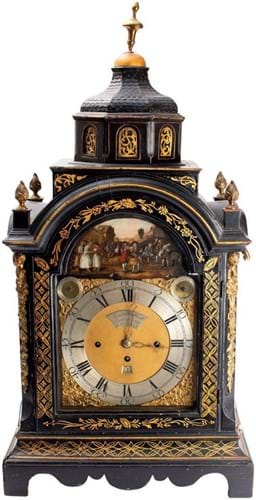It is famously the maker of ‘Big Ben’ – the turret clock that is arguably the best known in Britain thanks to its place in the Elizabeth tower of the Houses of Parliament (although strictly speaking Big Ben is the name of its largest bell).
The firm was started in 1814 by Edward J Dent and in 1830 joined forces with chronometer maker Roger Arnold to become Arnold & Dent, a partnership which lasted until 1840.
Productive partnership
Shown here is an 8½in (22cm) high striking and repeating carriage clock which is signed Arnold & Dent, London to the enamel dial and the backplate, and is dated to the middle of that 10- year partnership, c.1835.
The 8¼in (22cm) high scrollengraved brass case features a carrying handle and bevelled glass panels while the twin chain fusée movement with platform lever escapement and split bimetallic balance strikes the hour on a gong.
The clock sold for £8500, over double the £3000-4000 estimate, in Tennants (24% buyer’s premium) July 15 summer auction. A much more recent horological best-seller in the same auction was a 1000-year calendar and moon phases display Atmos du Millenaire Atlantis clock by Jaeger Le Coultre made c.1999 that was designed for the company by Robert Kohler to celebrate the year 2000 millennium.
The clock has an angled bevelled glass case on three conical shaped feet and a white spiral dial depicting the years between 2000-3000. It took £8000 against a guide of £4000-6000.
Village theme

An 18th century musical automaton bracket clock by Samuel West, £7000 at Bearnes Hampton & Littlewood.
Samuel West is an 18th century London clockmaker working at the Royal Exchange who is recorded as becoming a Freeman of the Clockmakers Company in 1766.
He produced this large automaton musical bracket clock which has his name engraved to a silvered plaque on the matted centre of the dial along with the date aperture.
The arch of the dial also features an automaton picture of a village scene as well as two subsidiary dials for chime/silent and tune change. The clock is fitted with an eight-day triple-fusée movement which plays four different airs on eight bells.
The 3ft (90cm) high ebonised clock case has gilt brass mounts, a pagoda pediment and a flame finial.
When it featured in Bearnes Hampton & Littlewood’s (25% buyer’s premium) July 11-12 summer auction in Exeter one of the top prices resulted as it was bid to £7000 (guide £5000-8000).















